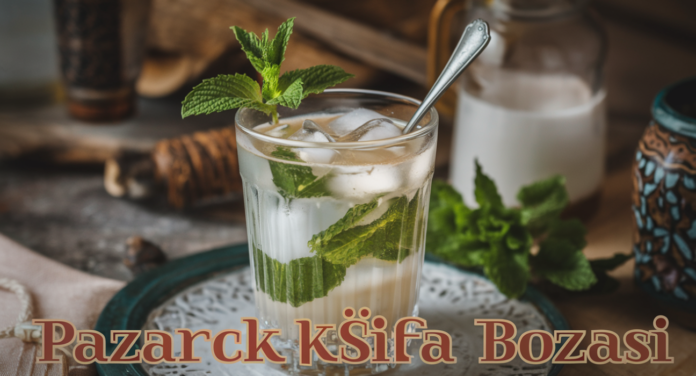In the heart of Turkey’s cultural and culinary heritage lies a plethora of traditional beverages, each with its unique history and preparation methods. Among these, Pazarcık Şifa Bozası stands out as a distinctive and beloved drink with a rich tradition and significant local importance. This essay explores the origins, preparation, cultural significance, and modern adaptations of Pazarcık Şifa Bozası, offering a comprehensive look at this traditional Turkish elixir.
Historical Background
Origins of Boza
Boza is an ancient fermented beverage with roots tracing back to the Middle East and Central Asia. Its origins can be traced to the early civilizations of Mesopotamia, where it was consumed as a nourishing drink. The word “boza” itself is derived from the Turkish word “buza,” which means fermented grain beverage. Over time, boza spread to various regions, including the Ottoman Empire, where it became popular across different social strata.
Emergence of Pazarcık Şifa Bozası
Pazarcık Şifa Bozası, specifically, has its origins in the Pazarcık district of Kahramanmaraş Province in southeastern Turkey. The region is known for its rich agricultural practices and traditional food and beverage preparations. Şifa Bozası is a regional variant of the broader boza tradition, distinguished by its unique preparation and local ingredients.
Preparation of Pazarcık Şifa Bozası
Ingredients
The preparation of Pazarcık Şifa Bozası involves a blend of simple yet essential ingredients. The core components include:
- Corn or Wheat: The primary grain used in Pazarcık Şifa Bozası is usually corn or wheat. These grains are crucial for the fermentation process.
- Water: Fresh, clean water is needed to mix with the grains.
- Yeast: Natural or commercial yeast is added to initiate the fermentation process.
- Sugar: Depending on taste preferences, sugar or other sweeteners might be added to balance the flavor.
Fermentation Process
The preparation of Pazarcık Şifa Bozası follows a traditional fermentation process:
- Preparation of Grains: The grains (corn or wheat) are cleaned and soaked in water. This softens the grains and prepares them for milling.
- Milling: Once softened, the grains are ground into a coarse flour.
- Mixing: The ground grains are mixed with water to create a thick, porridge-like consistency.
- Fermentation: Yeast is added to the mixture, which is then left to ferment for a period ranging from a few days to a week. During this time, the natural sugars in the grains are converted into alcohol and carbon dioxide, giving the beverage its characteristic tangy flavor and slight effervescence.
- Sweetening and Flavoring: After fermentation, the boza can be sweetened with sugar or other sweeteners. Some variations may include additional flavorings such as spices or fruits.
Traditional vs. Modern Methods
While the traditional method of preparing Pazarcık Şifa Bozası involves manual processes and local ingredients, modern adaptations have introduced new techniques and variations. Commercial producers might use advanced fermentation technologies and standardized ingredients to ensure consistency and efficiency. Despite these modern changes, the essence of Pazarcık Şifa Bozası remains rooted in its traditional preparation methods.
Cultural Significance
Traditional Role in Turkish Cuisine
Pazarcık Şifa Bozası holds a special place in Turkish cuisine, particularly in the Pazarcık region. Historically, it has been consumed as a nutritious and energizing drink, especially during the winter months. The fermentation process imparts a warming quality to the beverage, making it a popular choice in colder seasons.
Social and Cultural Aspects
Beyond its culinary significance, Pazarcık Şifa Bozası also plays a role in social and cultural practices. It is often served during communal gatherings, festivals, and special occasions. The preparation and sharing of Şifa Bozası can be a communal activity, reflecting the importance of togetherness and hospitality in Turkish culture.
Healing and Medicinal Beliefs
The term “Şifa” in Pazarcık Şifa Bozası translates to “healing” or “cure” in Turkish. Traditionally, Şifa Bozası is believed to have various health benefits due to its fermentation process. It is thought to aid digestion, improve gut health, and provide energy. While scientific evidence supporting these claims may be limited, the beverage’s association with wellness and healing is deeply ingrained in local beliefs.
Modern Adaptations and Commercialization
Rise of Commercial Production
In recent years, there has been a growing interest in traditional beverages like Pazarcık Şifa Bozası. This has led to the rise of commercial production and distribution. Local producers have started to bottle and sell Şifa Bozası, making it accessible to a wider audience beyond the Pazarcık region.
Challenges and Opportunities
The commercialization of Pazarcık Şifa Bozası presents both challenges and opportunities. On one hand, it allows for the preservation and promotion of traditional practices. On the other hand, there is a risk of losing the authenticity and artisanal qualities of the beverage. Striking a balance between tradition and modernity is crucial for maintaining the integrity of Pazarcık Şifa Bozası.
Innovation and Fusion
Modern adaptations of Pazarcık Şifa Bozası have also led to innovative variations. Some producers experiment with different flavors, ingredients, and packaging methods. These innovations aim to appeal to contemporary tastes while honoring the traditional essence of the beverage.
Conclusion
Pazarcık Şifa Bozası is more than just a traditional Turkish drink; it is a symbol of cultural heritage and communal values. Its rich history, unique preparation methods, and cultural significance make it a fascinating subject of study. As both traditional and modern influences shape its evolution, Pazarcık Şifa Bozası continues to be a cherished part of Turkish culinary tradition, representing the enduring connection between food, culture, and community.
